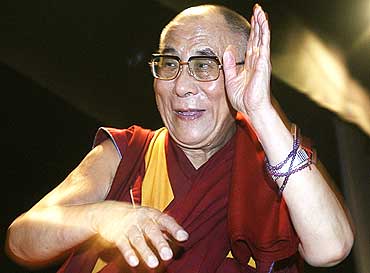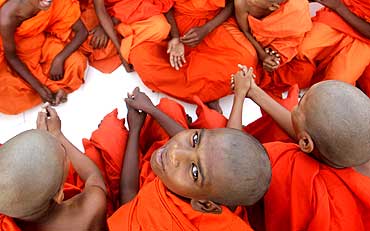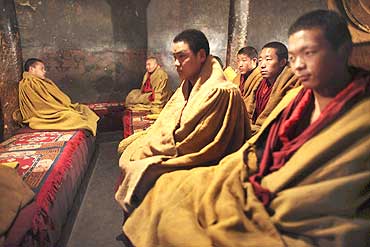
Claude Arpi reports on an enlightening interaction he had with His Holiness along with with a group of Indian and foreign scholars in Dharamsala recently.
The first segment of an exclusive two-part interview:
What fabulous fate for young toddler Lhamo Dhondrub, born 75 years ago in a small village of Amdo province, north-eastern Tibet. At the age of four he was recognised as the reincarnation of the 13th Dalai Lama and enthroned as the head of the Tibetan State.
For the Tibetan people, the living incarnation of Avalokiteshvara, the Buddha of Compassion, had again returned.
The serene state of the Roof of the World could have remained unperturbed for centuries, but it was not to be. In October 1950, China's People's Liberation Army walked unhindered on to Tibetan soil. A new ideology, less compassionate than the Buddha Dharma which had come from India 12 centuries earlier, 'liberated' the Land of Snows.
Nine years later, the young Dalai Lama had to flee his motherland and take refuge in India. He has now spent two-thirds of his life in this country. He recently met a group of Indian and foreign scholars at his home in Dharamsala.
In a free-wheeling discussion he explained what Tibet is for him, the importance of the Indian tradition of Nalanda and the differences between Buddhist science, philosophy and religion and why he believes that a 'sort' of cultural genocide is happening in Tibet today.

Geographical Aspect:
Tibet is considered as the Roof of the World. The geography (of Tibet) has nothing to do with politics.
Tibet is just the highest plateau in the world. All the major rivers of Asia, from Pakistan to China, have their origin in Tibet. These rivers are the basis for the life of 2 billion human beings.
The planet is now experiencing global warming and (there is) scarcity of water in many places. The ecology of Tibet has therefore become very crucial.
Some ecologists, including scientists of the Chinese Academy of Science, have realised that the rate of global warming (is different in Tibet). While it grows at an average of 0.1 degrees (for the rest) of the planet; it (increases) by 0.3 degree for the Tibetan plateau. It means that it goes faster (on the Tibetan plateau).
When I was in Lhasa (before 1959), elderly people used to tell us that the climate was becoming warmer. They said that when they were young, there was more snow (on the peaks) around Lhasa. In my teenage days, there was already much less snow. The (global) warming had already started.
We need more studies from the part of the countries (served) by rivers (originating in Tibet). We have to educate people about this issue. People have to realise that the ecology of the (Tibetan plateau) is very important.Some Indian scholars once told me that because Tibet has a dry climate and high altitude, when some damage occurred, nature takes more time to recover. We also have to take this aspect seriously. The Tibetan environment is rather delicate.

Today the Chinese are proud of their economy which is very strong, but at the same time, they are eager to exploit the natural resources inside Tibet, and this regardless of the consequences for the ecology. It is a crucial matter.
In some areas, which had been covered by thick forests for thousands of years, during the past 50 years, there has been an intense deforestation.
As a result, when he was Chinese premier, Zhu Rongji (1998 to 2003) gave instructions that deforestation should stop in these high altitude areas. But there is corruption.
Despite the (central) government instructions to local officials, deforestation is going on, thanks to corruption. Some Chinese businessmen do not care about government orders or restrictions.
On one hand there are government restrictions, (on the other), there is no implementation.
We need more study and the preservation of the Tibetan ecology, at any cost. It is very, very important for all South Asian nations.
Cultural and Religious aspects
Then the other aspect is the Tibetan culture. In the early part of the 20th century, Western scholars or Tibetologists considered that Tibetan Buddhism was not true Buddhism. They believed that it was mixed with local faith, Bon. They called it a special name, 'Lamaism'.
Last year, I met two Burmese monks in Melbourne, Australia on the occasion of a World Parliamentary Religious Gathering.
They asked to see me, I said 'yes'. I must say that I have great respect for (the) Hinayana (tradition) and wear the yellow robe myself. The (two monks) were also showing a genuine feeling of Buddhist brotherhood. But then, they said: "We are the students of the same teacher, the Buddha Sakyamuni, but we have big differences".
I thought (that they talk this way) because some Western scholars have described Tibetan Buddhism as 'Lamaism' and (said that it was not) genuine Buddhism (laughing).
Then I explained to them about the Tibetan monk's robes as per the Pratimoksha, the basic code of monastic discipline, (consisting of rules for ordained monks). I explained to some extent about the Pratimoksha according to the Mulasarvastivada (the monk tradition prevalent in Tibet since the 8th century AD).
The text was originally written in Sanskrit. In the Theravada tradition which is practiced in Thailand, Burma, Sri Lanka, the Pratimoksha is written in Pali. There are small differences.
According to the Sanskrit Pratimoksha scripture, which is used in Tibet, there are 253 precepts; according to the Theravada (in Pali) there are 227. These are therefore minor differences.
I have studied the differences between the two texts. I compared them. The major precepts are 100 per cent the same. There are minor things, for example, our Pratimoksha mentions that the lower robe should not be below the ankle and be above the knee (His Holiness demonstrates).
In our tradition we have seven points (about the lower robe), in the Pali tradition there is only one, (you should wear the robe properly). It has very minor differences.
The same way, there are some other differences. But basically, there are the same precepts. I explained this to these two monks. They were shocked. There was an expression of surprise (on their faces): "Oh, Tibetan Buddhism has the same practices".
(My conclusion is that) wrong information creates the wrong impression.
I always describe Tibetan Buddhism as pure Buddhism from the Nalanda tradition. In Mahayana Buddhism, whether it is from China, Japan, Korea, Vietnam or Tibetan, also Mongolia, we all recite the same Saddharma Pundarika Sutra or Lotus Sutra.
We recite the same texts, all translated from Sanskrit. We all practice Mahayana.
The Buddhist tradition of Nalanda uses Sanskrit language; Nalanda is the true promoter of the Mahayana tradition. Nalanda had great masters like Nagarjuna and Arya Asanga.
The important point is that during the 8th century, the Tibetan emperor invited a great master of Nalanda. His name was Shantarakshita. He was a famous, well-known scholar and master of Nalanda. He went to Tibet and spent the rest of his life there. He introduced Buddhism in Tibet. That is why I consider that Tibetan Buddhism is the authentic tradition of Nalanda.
I myself studied the Nalanda tradition of Buddhism; first I learned by heart and memorised what we call the Root Texts. All these Root Texts have been written by Nalanda masters. Then, I continued the study and learned word by word with the help of commentaries, mainly written by Indian Masters from Nalanda. Of course, we have also some Tibetan commentaries.
Therefore the Tibetan Buddhist tradition is the Nalanda tradition which combines the Sanskrit and the Pali traditions as well as Buddhist Tantrayana. Masters like Nagarjuna, Aryadeva and Chandrakirti wrote tantric treatises (in Sanskrit).

Yes, it is Buddhist Tantrayana or Vajrayana. Of course, Hindu Tantrayana is also there.
Once a Hindu tantric practitioner came here, he was from Gorakhpur (Uttar Pradesh). There is a lot of similarities, but the Hindu Tantrayana is based on Atma (soul) theory. We Buddhists do not believe in the Atma.
There are two theories, Atma and Anatma, the existence of an independent self or its non-existence (selflessness). It is the main demarcation between Buddhism and Hinduism.
Japanese, Chinese, Tibetans, who are Buddhists do not believe in the existence of an independent self, Atma.
A Japanese friend, who is the abbot of one monastery (in Japan) told me (in fact many Japanese told me the same thing): "We also recite the Saddharma Pundarika Sutra, the Heart Sutra, and we use the term 'emptiness', but without understanding the meaning" (laughing).
It is also true for us Tibetans, unless you study seriously and meditate; it is difficult to (understand). Just recitation of the words is meaningless.
Nowadays, Western scholars or Tibetologists realise that Tibetan Buddhism is really the same as the Indian tradition of Nalanda and the knowledge of Tibetan scholars is truly complete.

Yes, it is complete. Like Nagarjuna, himself a monk, he practiced Pratimoksha, which is the same in Sanskrit and Pali traditions. Most of the texts like the Mulamadhyamaka-karika (The Fundamental Verses on the Middle Way) of Nagarjuna were in Sanskrit. It is one of the main texts of the Mahayana tradition.
One great Indian nuclear physicist, Dr Raja Ramanna, told me that he once read this text of Nagarjuna, he was surprised when he found in this text the concept of quantum physics and relativity.
The West discovered these concepts at the end of the 19th century or the beginning of the 20th century when some Indian sages like Nagarjuna knew it 2,000 years ago.
As a physicist, (Dr Ramana) was really surprised.
I want (here to) make a distinction, when we speak of Buddhism, we have the impression that we are speaking of a religious tradition.
Since I began my contacts with Western scientists over the past 27 years, we have had some serious discussions. We have been meeting annually; the interest is from both sides. The contacts between Western scientists and the Tibetan scholars have grown much closer.
For the past several years, I make a distinction between Buddhist philosophy and Buddhist science. When some people spoke of a dialogue between Modern Sciences and Buddhism, I made a correction, the word 'Buddhism' is misleading.
Buddhism, like Jainism does not have the concept of a creator. It is not based on a creator, but on the law of cause and effect (or Law of Causality). It is similar to the Darwinian Theory. Therefore ultimately, action is the real cause of all events.
Action entirely depends on motivation. Motivation means the mind, emotions, etc.
In order to tackle emotions, to reduce destructive emotions and increase constructive emotions, you have to know what is 'emotion' and the root cause of the emotion.
In Hinduism, you have three things Shila (abstinence from killing, stealing, lying, sexual misconduct and intoxication), Samadhi (concentration), and Prajna (understanding, discernment or cognitive acuity).
The serious practitioners first go through Shila, many physical practices, several disciplines, etc, then Samadhi (Dhyana), concentration, one pointed concentration, then Vipassana. Buddhism, Jainism and Hinduism have the same.
Samadhi and Vipassana are the workings of mind. We have to know about the mind.
In Buddhism, there is a lot of explanation about the mind, many categories of mind. Therefore Buddhism could be considered as 'science of mind'. The science of Buddhism is not necessarily the Buddhist religion.
That is one aspect.
Another is the Buddhist philosophy (or concept), like the Buddhist relativity of things; then, you have Buddhist religion.
When I contact modern scientists, I don't put them in contact with Buddhist religion, but with Buddhist science and to some extent to Buddhist philosophy.
It is important (to understand) that when we say 'Buddhist science', we mean science of the mind; it is something universal; it is not a religion.
Buddhist religion is not universal, it is only for Buddhists. This is clear.
These scientists (that I am meeting) do not want to become Buddhist; some of them are Christians, many are atheists, some have no religious beliefs, but they are interested in Buddhist experiences and explanations, or techniques for (studying) the mind and emotions.
Therefore, I thought it was useful to make the distinction between Buddhist science, Buddhist philosophy and Buddhist religion.

Usually, I say that there are three ways to promote morality or moral ethics.
One is through a theistic religion which believes in a God, created by God who is an infinite Love; one must follow the example of God. It is one way to promote moral ethics. It is not universal.
Then, for those who believe in a non-theistic faith like Jainism or Buddhism, and some part of Sankya. There is no God, no Creator.
If you harm others, you will have to face the consequences. If you help others, you will get benefits; that much only. That is the Law of Casualty. That is not universal.
There must be a third one which is universal; the two first ones are not. The third one does not depend on religion, but is based on our common experience. If you show me some sincere, truthful, kind attitude, I feel happy.
Similarly if I show you the same attitude, I feel happy. If I have some suspicion towards you, you may smile, saying nice words, but inside you have a deep suspicion, this will immediately destroy your peace of mind. It is common experience.
If you are honest, compassionate, kind, you get the benefit and peace of mind, which in turn can immensely benefit your health. Constant fear, doubt, distrust, hatred eat into our immune system, say some scientists.
We are social animals. The future of the individuals depends on society, but if you develop suspicion, (it harms society).
Of course, I don't want to make political comments, but the Chinese Communist hardliners are always suspicious; they even distrust their own comrades. How can there be genuine inner peace or friendship (in these conditions)?
Friendship is highly necessary for social animals. The best way to develop genuine friendship is trust, mutual respect. It is the basis.
If you are full of suspicion, how to have a friendship? And cooperation, for genuine cooperation, harmony is also important.
If there is a chance, I would like to tell President Hu Jintao who speaks of the promotion of harmonious society, that it is excellent. However, if he really wants to develop a harmonious society, transparency is really necessary, free information is very necessary. How is it possible (to develop a harmonious society) with censorship?
The two first ones are about theistic and atheistic religion, which is the third one?
Without touching religion, just according to our common sense, our common experience. First of all, we all come from our mother. Though there were some stories in Tibet that some Lamas were born out a Lotus, it is very beautiful and poetic, but (at the end), these people born out of lotuses may have more compassion towards lotuses than human beings (laughing.
We are fortunate to have as a mother, another human being (as a mother).
We naturally have the seed for love towards other human beings, just because our mother provided us with maximum affection, love and compassion.
The children who receive maximum love and compassion from their mother, their mind is much more stable; they are happier; they study better. While those children who don't have a mother, or if the mother is very bad (laughing), these children psychologically suffer deep inside.
I like the way Shakespeare in Macbeth speaks of 'the milk of human kindness'. He links mother's milk to human love.
That is right.